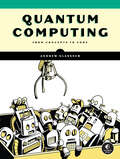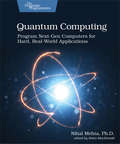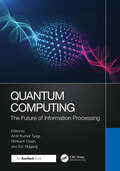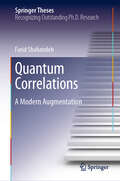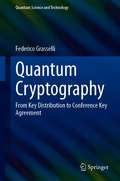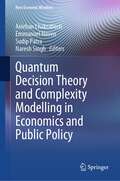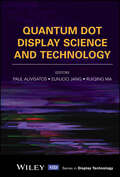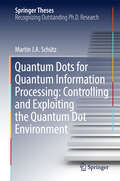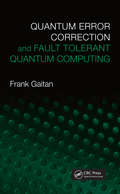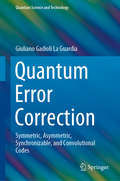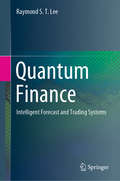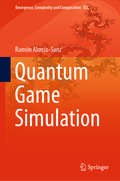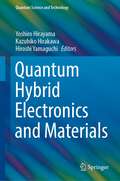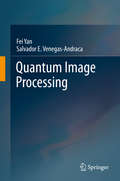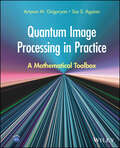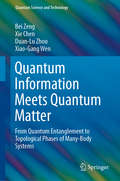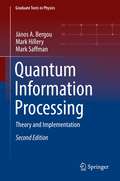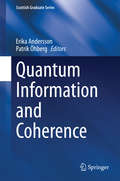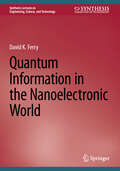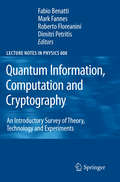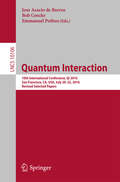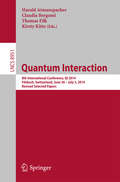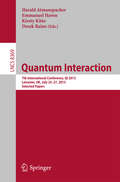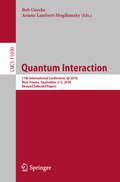- Table View
- List View
Quantum Computing: From Concepts to Code
by Andrew GlassnerA friendly introduction to quantum programming.What if you had a computer that could process billions of different inputs at the same time?Quantum computing is a radically new way to think about algorithms and data. It can feel mysterious or technically challenging, but it doesn&’t have to be. If you want to understand how quantum computers work—and how to program them—this friendly, self-contained guide is for you.This approachable yet rigorous book walks you step-by-step through quantum computing fundamentals, such as superposition, quantum gates, interference, entanglement, and measurement, then teaches you how to write real quantum programs.Along the way, you&’ll:Understand how to store and transform quantum informationGrasp the surprising process of quantum measurementExplore Simon&’s, Grover&’s, and Shor&’s algorithmsWrite and run your own quantum code using free simulators and live hardwareAuthor Andrew Glassner is known for turning complex topics into accessible and enjoyable learning experiences. In this book, he brings visual thinking, clarity, context, and precision to the strange and fascinating world of quantum programming. All the ideas and math are built up slowly so you&’ll master every step.Whether you&’re a programmer, student, educator, scientist, poet, or anyone else who loves new ideas that stretch your mind, this is the guide that will take you from &“What is a qubit?&” to writing and running working quantum algorithms with curiosity, creativity, and confidence.
Quantum Computing: Program Next-gen Computers For Hard, Real-world Applications
by Nihal MehtaYou've heard that quantum computing is going to change the world. Now you can check it out for yourself. Learn how quantum computing works, and write programs that run on the IBM Q quantum computer, one of the world's first functioning quantum computers. Learn a simple way to apply quantum mechanics to computer programming. Create algorithms to solve intractable problems for classical computers, and discover how to explore the entire problem space at once to determine the optimal solution. Get your hands on the future of computing today. Quantum computing overhauls computer science. Problems such as designing life-saving drugs and super-large logistics problems that have been difficult or impossible for classical computers to handle can now be solved in moments. Quantum computing makes it possible to explore all possible solutions simultaneously and determine those that work, instead of iterating through each possibility sequentially. Work with quantum computers directly, instead of talking about them theoretically. Discover a new visual way of looking at quantum bits that makes quantum computing intuitive for computer programmers. Master the special properties that make them different, and more powerful, than classical bits. Control quantum bits with gates and create circuits to model complex problems. Write programs that run on real quantum machines to solve problems that classical computers struggle with. Dive into quantum optimization and cryptography. Get a head start on the technology that will drive computer science into the future. What You Need: Access to the IBM quantum computer, via any internet connection
Quantum Computing: The Future of Information Processing
by Amit Kumar Tyagi Shrikant Tiwari S. V. NagarajQuantum computing and algorithms are set to revolutionize information processing. Covering such topics, Quantum Computing: The Future of Information Processing explains its principles, practical applications, and future implications in a clear and accessible manner. The book strives to simplify the essential concepts and practical applications of quantum computing. Its aim is to help students and researchers to apply quantum computing to advance AI and machine learning, cybersecurity, and blockchain. With its emphasis on practical applications, the book covers how quantum computing is changing such fields as: Finance Medicine Built environment Networking and communications With extensive real-world case studies and practical implementation guidance, the book is a guide for those seeking to understand how quantum computing is applied in various industries. Its in-depth exploration of quantum computing covers both foundational principles and advanced applications in a single resource, saving readers the need to purchase multiple books. Finally, the book focuses on the future of information processing so that students and researchers can anticipate and prepare for the transformative impact of quantum computing.
Quantum Correlations: A Modern Augmentation (Springer Theses)
by Farid ShahandehThe correlations between physical systems provide significant information about their collective behaviour – information that is used as a resource in many applications, e.g. communication protocols. However, when it comes to the exploitation of such correlations in the quantum world, identification of the associated ‘resource’ is extremely challenging and a matter of debate in the quantum community. This dissertation describes three key results on the identification, detection, and quantification of quantum correlations. It starts with an extensive and accessible introduction to the mathematical and physical grounds for the various definitions of quantum correlations. It subsequently focusses on introducing a novel unified picture of quantum correlations by taking a modern resource-theoretic position. The results show that this novel concept plays a crucial role in the performance of collaborative quantum computations that is not captured by the standard textbook approaches. Further, this new perspective provides a deeper understanding of the quantum-classical boundary and paves the way towards establishing a resource theory of quantum computations.
Quantum Cryptography: From Key Distribution to Conference Key Agreement (Quantum Science and Technology)
by Federico GrasselliRising concerns about the security of our data have made quantum cryptography a very active research field in recent years. Quantum cryptographic protocols promise everlasting security by exploiting distinctive quantum properties of nature. The most extensively implemented protocol is quantum key distribution (QKD), which enables secure communication between two users. The aim of this book is to introduce the reader to state-of-the-art QKD and illustrate its recent multi-user generalization: quantum conference key agreement. With its pedagogical approach that doesn’t disdain going into details, the book enables the reader to join in cutting-edge research on quantum cryptography.
Quantum Decision Theory and Complexity Modelling in Economics and Public Policy (New Economic Windows)
by Anirban Chakraborti Emmanuel Haven Sudip Patra Naresh SinghThis book is an outcome of the interdisciplinary conference held at OP Jindal Global University (Quantum Decision-making and Complexity modeling, and their possible applications in social sciences- economics, finance and public policy). The volume builds upon the emerging fields of Econophysics, Complexity theory and Quantum like modelling in cognition and social sciences, and their plausible applications in economics and public policy. There can be deep linkages between the micro, meso and macro scales at which these paradigms operate. In this data-driven age, greater amounts of information, along with the facility to harvest, sort and process said information, have permitted an expansion of the capability to study a society’s various factors to a degree of detail and inclusiveness that has never before been available to researchers. As a result, an increasing number of throughlines is being discovered, revealing heretofore unknown connections between various disciplines and enhancing the study of such societal tropes as finance, language, shared behavior, and many others. As the reader will see, with clearer understanding of the interconnectedness of society’s assorted parts comes a clearer understanding of the society as a whole. We have received critical thoughts from noted experts in social and natural sciences to explore possible interconnections. The editors of this book earnestly hope that the critical reviews presented in this volume will stimulate further scholarly interest, but also interest among policy practitioners for the purpose of exploring possibilities for creating a new paradigm for comprehending pressing issues of deep uncertainty and emergence in social dynamics.
Quantum Dot Display Science and Technology (Wiley Series in Display Technology)
by Ruiqing Ma Paul Alivisatos Eunjoo JangCOMPREHENSIVE REFERENCE PRESENTING ALL ASPECTS OF QUANTUM DOT-BASED DISPLAY TECHNOLOGIES IN FOUR PARTS, SUPPORTED WITH PEDAGOGICAL FEATURES Quantum Dot Display Science and Technology presents all aspects of quantum dot (QD) based display technologies, divided into four general topic areas: the basic science of quantum dots, QD photoluminescent technologies, QD electroluminescent technologies, and other display related QD technologies. Composed of 14 chapters, this book includes a list of pedagogical features such as tables, illustrations, process flow charts, and more to provide active learning for the reader. This book also includes information on future quantum dot displays and the major milestones in the field. Quantum Dot Display Science and Technology discusses topics including: The basic physics and photophysics of QD, explaining why QD can offer better color and higher brightnessQD material systems and compositional families as well as principles and practices of QD synthesisQuantum dot enhancement film and quantum dot color conversion for LCDs, OLEDs, and μLEDsQuantum dot electroluminescent displays and QD-LED panel processes based on ink-jet printing and lithographyQD for lighting and photodetector applicationsFuture outlook for QD displays Published in partnership with the Society for Information Display (SID), Quantum Dot Display Science and Technology is the perfect resource for updated information on quantum dots and their applications for professionals working in displays, consumer electronics, and product design and development.
Quantum Dots for Quantum Information Processing: Controlling and Exploiting the Quantum Dot Environment
by Martin J. A. SchützThis thesis offers a comprehensive introduction to surface acoustic waves in the quantum regime. It addresses two of the most significant technological challenges in developing a scalable quantum information processor based on spins in quantum dots: (i) decoherence of the electronic spin qubit due to the surrounding nuclear spin bath, and (ii) long-range spin-spin coupling between remote qubits. Electron spins confined in quantum dots (QDs) are among the leading contenders for implementing quantum information processing. To this end, the author pursues novel strategies that turn the unavoidable coupling to the solid-state environment (in particular, nuclear spins and phonons) into a valuable asset rather than a liability.
Quantum Error Correction and Fault Tolerant Quantum Computing
by Frank GaitanIt was once widely believed that quantum computation would never become a reality. However, the discovery of quantum error correction and the proof of the accuracy threshold theorem nearly ten years ago gave rise to extensive development and research aimed at creating a working, scalable quantum computer. Over a decade has passed since this monumental accomplishment yet no book-length pedagogical presentation of this important theory exists.Quantum Error Correction and Fault Tolerant Quantum Computing offers the first full-length exposition on the realization of a theory once thought impossible. It provides in-depth coverage on the most important class of codes discovered to date—quantum stabilizer codes. It brings together the central themes of quantum error correction and fault-tolerant procedures to prove the accuracy threshold theorem for a particular noise error model. The author also includes a derivation of well-known bounds on the parameters of quantum error correcting code. Packed with over 40 real-world problems, 35 field exercises, and 17 worked-out examples, this book is the essential resource for any researcher interested in entering the quantum field as well as for those who want to understand how the unexpected realization of quantum computing is possible.
Quantum Error Correction: Symmetric, Asymmetric, Synchronizable, and Convolutional Codes (Quantum Science and Technology)
by Giuliano Gadioli La GuardiaThis text presents an algebraic approach to the construction of several important families of quantum codes derived from classical codes by applying the well-known Calderbank-Shor-Steane (CSS), Hermitian, and Steane enlargement constructions to certain classes of classical codes. In addition, the book presents families of asymmetric quantum codes with good parameters and provides a detailed description of the procedures adopted to construct families of asymmetric quantum convolutional codes.Featuring accessible language and clear explanations, the book is suitable for use in advanced undergraduate and graduate courses as well as for self-guided study and reference. It provides an expert introduction to algebraic techniques of code construction and, because all of the constructions are performed algebraically, it enables the reader to construct families of codes, rather than only codes with specific parameters. The text offers an abundance of worked examples, exercises, and open-ended problems to motivate the reader to further investigate this rich area of inquiry. End-of-chapter summaries and a glossary of key terms allow for easy review and reference.
Quantum Finance: Intelligent Forecast and Trading Systems
by Raymond S. LeeWith the exponential growth of program trading in the global financial industry, quantum finance and its underlying technologies have become one of the hottest topics in the fintech community. Numerous financial institutions and fund houses around the world require computer professionals with a basic understanding of quantum finance to develop intelligent financial systems. This book presents a selection of the author’s past 15 years’ R&D work and practical implementation of the Quantum Finance Forecast System – which integrates quantum field theory and related AI technologies to design and develop intelligent global financial forecast and quantum trading systems. The book consists of two parts: Part I discusses the basic concepts and theories of quantum finance and related AI technologies, including quantum field theory, quantum price fields, quantum price level modelling and quantum entanglement to predict major financial events. Part II then examines the current, ongoing R&D projects on the application of quantum finance technologies in intelligent real-time financial prediction and quantum trading systems. This book is both a textbook for undergraduate & masters level quantum finance, AI and fintech courses and a valuable resource for researchers and data scientists working in the field of quantum finance and intelligent financial systems. It is also of interest to professional traders/ quants & independent investors who would like to grasp the basic concepts and theory of quantum finance, and more importantly how to adopt this fascinating technology to implement intelligent financial forecast and quantum trading systems. For system implementation, the interactive quantum finance programming labs listed on the Quantum Finance Forecast Centre official site (QFFC.org) enable readers to learn how to use quantum finance technologies presented in the book.
Quantum Game Simulation (Emergence, Complexity and Computation #36)
by Ramon Alonso-SanzThis book addresses two disciplines that have traditionally occupied completely different realms: quantum information and computation, and game theory. Helping readers connect these fields, it appeals to a wide audience, including computer scientists, engineers, mathematicians, physicists, biologists or economists. The book is richly illustrated and basic concepts are accessible to readers with basic training in science. As such it is useful for undergraduate students as well as established academicians and researchers. Further, the didactic and tutorial-like style makes it ideal supplementary reading for courses on quantum information and computation, game theory, cellular automata and simulation.
Quantum Hybrid Electronics and Materials (Quantum Science and Technology)
by Hiroshi Yamaguchi Yoshiro Hirayama Kazuhiko HirakawaThis book highlights recent advances in quantum control technologies with regard to hybrid quantum systems. It addresses the following topics: phonon engineering based on phononic crystals, carbon-based nano materials like graphene and nanotubes, Terahertz light technology for single-molecule and quantum dots, nuclear-spin-based metrology for semiconductor quantum systems, quantum anomalous Hall effect in magnetic topological insulators, chiral three-dimensional photonic crystals, and bio-inspired magnonic systems. Each topic, as a component in the framework of hybrid quantum systems, is concisely presented by experts at the forefront of the field. Accordingly, the book offers a valuable asset, and will help readers find advanced technologies and materials suitable for their purposes.
Quantum Image Processing
by Fei Yan Salvador E. Venegas-AndracaThis book provides a comprehensive introduction to quantum image processing, which focuses on extending conventional image processing tasks to the quantum computing frameworks. It summarizes the available quantum image representations and their operations, reviews the possible quantum image applications and their implementation, and discusses the open questions and future development trends. It offers a valuable reference resource for graduate students and researchers interested in this emerging interdisciplinary field.
Quantum Image Processing in Practice: A Mathematical Toolbox
by Artyom M. Grigoryan Sos S. AgaianComprehensive resource addressing the need for a quantum image processing machine learning model that can outperform classical neural networks Quantum Image Processing in Practice explores the transformative potential of quantum color image processing across various domains, including biomedicine, entertainment, economics, and industry. The rapid growth of image data, especially in facial recognition and autonomous vehicles, demands more efficient processing techniques. Quantum computing promises to accelerate digital image processing (DIP) to meet this demand. This book covers the role of quantum image processing (QIP) in quantum information processing, including mathematical foundations, quantum operations, image processing using quantum filters, quantum image representation, and quantum neural networks. It aims to inspire practical applications and foster innovation in this promising field. Topics include: Qubits and Quantum Logic Gates: Introduces qubits, the fundamental data unit in quantum computing, and their manipulation using quantum logic gates like Pauli matrices, rotations, the CNOT gate, and Hadamard matrices. The concept of entanglement, where qubits become interconnected, is also explored, highlighting its importance for applications like quantum teleportation and cryptography. Two and Multiple Qubit Systems: Demonstrates the importance of using two qubits to process color images, enabling image enhancement, noise reduction, edge detection, and feature extraction. Covers the tensor product, Kronecker sum, SWAP gate, and local and controlled gates. Extends to multi-qubit superpositions, exploring local and control gates for three qubits, such as the Toffoli and Fredkin gates, and describes the measurement of superpositions using projection operators. Transforms and Quantum Image Representations: Covers the Hadamard, Fourier, and Heap transforms and their circuits in quantum computation, highlighting their applications in signal and image processing. Introduces the quantum signal-induced heap transform for image enhancement, classification, compression, and filtration. Explores quantum representations and operations for images using the RGB, XYZ, CMY, HSI, and HSV color models, providing numerous examples. Fourier Transform Qubit Representation: Introduces a new model of quantum image representation, the Fourier transform qubit representation. Describes the algorithm and circuit for calculating the 2-D quantum Fourier transform, enabling advancements in quantum imaging techniques. New Operations and Hypercomplex Algebra: Presents new operations on qubits and quantum representations, including multiplication, division, and inverse operations. Explores hypercomplex algebra, specifically quaternion algebra, for its potential in color image processing. Quantum Neural Networks (QNNs): Discusses QNNs and their circuit implementation as advancements in machine learning driven by quantum mechanics. Summarizes various applications of QNNs and current trends and future developments in this rapidly evolving field. The book also addresses challenges and opportunities in QIP research, aiming to inspire practical applications and innovation. It is a valuable resource for researchers, students, and professionals interested in the intersection of quantum computing and color image processing applications, as well as those in visual communications, multimedia systems, computer vision, entertainment, and biomedical applications.
Quantum Information Meets Quantum Matter: From Quantum Entanglement to Topological Phases of Many-Body Systems (Quantum Science and Technology)
by Bei Zeng Xie Chen Duan-Lu Zhou Xiao-Gang WenThis book approaches condensed matter physics from the perspective of quantum information science, focusing on systems with strong interaction and unconventional order for which the usual condensed matter methods like the Landau paradigm or the free fermion framework break down. Concepts and tools in quantum information science such as entanglement, quantum circuits, and the tensor network representation prove to be highly useful in studying such systems. The goal of this book is to introduce these techniques and show how they lead to a new systematic way of characterizing and classifying quantum phases in condensed matter systems. The first part of the book introduces some basic concepts in quantum information theory which are then used to study the central topic explained in Part II: local Hamiltonians and their ground states. Part III focuses on one of the major new phenomena in strongly interacting systems, the topological order, and shows how it can essentially be defined and characterized in terms of entanglement. Part IV shows that the key entanglement structure of topological states can be captured using the tensor network representation, which provides a powerful tool in the classification of quantum phases. Finally, Part V discusses the exciting prospect at the intersection of quantum information and condensed matter physics – the unification of information and matter. Intended for graduate students and researchers in condensed matter physics, quantum information science and related fields, the book is self-contained and no prior knowledge of these topics is assumed.
Quantum Information Processing with Finite Resources
by Marco TomamichelThis book provides the reader with the mathematical framework required to fully explore the potential of small quantum information processing devices. As decoherence will continue to limit their size, it is essential to master the conceptual tools which make such investigations possible. A strong emphasis is given to information measures that are essential for the study of devices of finite size, including Rényi entropies and smooth entropies. The presentation is self-contained and includes rigorous and concise proofs of the most important properties of these measures. The first chapters will introduce the formalism of quantum mechanics, with particular emphasis on norms and metrics for quantum states. This is necessary to explore quantum generalizations of Rényi divergence and conditional entropy, information measures that lie at the core of information theory. The smooth entropy framework is discussed next and provides a natural means to lift many arguments from information theory to the quantum setting. Finally selected applications of the theory to statistics and cryptography are discussed. The book is aimed at graduate students in Physics and Information Theory. Mathematical fluency is necessary, but no prior knowledge of quantum theory is required.
Quantum Information Processing: Theory and Implementation (Graduate Texts in Physics)
by Mark Hillery János A. Bergou Mark SaffmanThis new edition of a well-received textbook provides a concise introduction to both the theoretical and experimental aspects of quantum information at the graduate level. While the previous edition focused on theory, the book now incorporates discussions of experimental platforms. Several chapters on experimental implementations of quantum information protocols have been added: implementations using neutral atoms, trapped ions, optics, and solidstate systems are each presented in its own chapter. Previous chapters on entanglement, quantum measurements, quantum dynamics, quantum cryptography, and quantum algorithms have been thoroughly updated, and new additions include chapters on the stabilizer formalism and the Gottesman-Knill theorem as well as aspects of classical and quantum information theory. To facilitate learning, each chapter starts with a clear motivation to the topic and closes with exercises and a recommended reading list. Quantum Information Processing: Theory and Implementation will be essential to graduate students studying quantum information as well as and researchers in other areas of physics who wish to gain knowledge in the field.
Quantum Information and Coherence
by Erika Andersson Patrik ÖhbergThis book offers an introduction to ten key topics in quantum information science and quantum coherent phenomena, aimed at graduate-student level. The chapters cover some of the most recent developments in this dynamic research field where theoretical and experimental physics, combined with computer science, provide a fascinating arena for groundbreaking new concepts in information processing. The book addresses both the theoretical and experimental aspects of the subject, and clearly demonstrates how progress in experimental techniques has stimulated a great deal of theoretical effort and vice versa. Experiments are shifting from simply preparing and measuring quantum states to controlling and manipulating them, and the book outlines how the first real applications, notably quantum key distribution for secure communication, are starting to emerge. The chapters cover quantum retrodiction, ultracold quantum gases in optical lattices, optomechanics, quantum algorithms, quantum key distribution, quantum control based on measurement, orbital angular momentum of light, entanglement theory, trapped ions and quantum metrology, and open quantum systems subject to decoherence. The contributing authors have been chosen not just on the basis of their scientific expertise, but also because of their ability to offer pedagogical and well-written contributions which will be of interest to students and established researchers.
Quantum Information in the Nanoelectronic World (Synthesis Lectures on Engineering, Science, and Technology)
by David K. FerryThis book provides a concise introduction to quantum information and quantum science. The author discusses in language accessible to a broad audience, the why and how, as well as implementation technologies. The discussion includes coverage of general computing (e.g., Turing ideas) for comparison, and ideas like entropy and minimum dissipation. Topics such as quantum communications and quantum sensing enhance the discussion of quantum computing. In addition, the manner in which entanglement is used in each of these sub-fields is addressed with applications and, for example, a discussion of the quantum Fourier transform.
Quantum Information, Computation and Cryptography
by Fabio Benatti Dimitri Petritis Mark Fannes Roberto FloreaniniThis multi-authored textbook addresses graduate students with a background in physics, mathematics or computer science. No research experience is necessary. Consequently, rather than comprehensively reviewing the vast body of knowledge and literature gathered in the past twenty years, this book concentrates on a number of carefully selected aspects of quantum information theory and technology. Given the highly interdisciplinary nature of the subject, the multi-authored approach brings together different points of view from various renowned experts, providing a coherent picture of the subject matter. The book consists of ten chapters and includes examples, problems, and exercises. The first five present the mathematical tools required for a full comprehension of various aspects of quantum mechanics, classical information, and coding theory. Chapter 6 deals with the manipulation and transmission of information in the quantum realm. Chapters 7 and 8 discuss experimental implementations of quantum information ideas using photons and atoms. Finally, chapters 9 and 10 address ground-breaking applications in cryptography and computation.
Quantum Interaction
by Emmanuel Pothos Bob Coecke Jose Acacio de BarrosThis book constitutes the thoroughly refereed post-conference proceedings of the 10th International Conference on Quantum Interaction, QI 2016, held in San Francisco, CA, USA, in July 2016. The 21 papers presented in this book were carefully reviewed and selected from 39 submissions. The papers address topics such as: Fundamentals; Quantum Cognition; Language and Applications; Contextuality and Foundations of Probability; and Quantum-Like Measurements.
Quantum Interaction
by Harald Atmanspacher Thomas Filk Claudia Bergomi Kirsty KittoThis book constitutes the refereed proceedings of the 8th International Conference on Quantum Interaction, QI 2014, held in Filzbach, Switzerland, in June/July 2014. The 19 papers together with 20 invited keynotes presented in this book were carefully selected from 22 submissions. Quantum Interaction has developed into an emerging interdisciplinary area of science combining research topics in fundamental issues, semantic and memory, decision making, games, politics and social aspects, non-locality and entanglement.
Quantum Interaction
by Emmanuel Haven Harald Atmanspacher Kirsty Kitto Derek RaineThis book constitutes the refereed proceedings of the 7th International Conference on Quantum Interaction, QI 2013, held in Leicester, UK, in July 2013. The 31 papers presented in this book were carefully selected from numerous submissions. The papers cover various topics on quantum interaction and revolve around four themes: information processing/retrieval/semantic representation and logic; cognition and decision making; finance/economics and social structures and biological systems.
Quantum Interaction: 11th International Conference, QI 2018, Nice, France, September 3–5, 2018, Revised Selected Papers (Lecture Notes in Computer Science #11690)
by Bob Coecke Ariane Lambert-MogilianskyThis book constitutes the thoroughly refereed post-conference proceedings of the 10th International Conference on Quantum Interaction, QI 2018, held in Nice, France, in September 2018.The 12 papers presented in this book were carefully reviewed and selected from 15 submissions. The papers address topics such as: psychology, economics, semantic and memory, natural language processing, cognition, information retrieval, biology, and political science.
